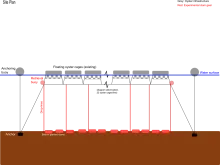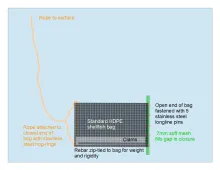Unlike land based agriculture, subtidal aquaculture offers the opportunity for farmers to expand their operations and diversify their crops by utilizing the vertical space of the water column. Most seafarms are monocultures that only use the portion of the water column that provides their specific crop optimal growth. Adding a species with different environmental needs would allow a farmer to expand in-place and reap the benefits of additional products and increased operational resilience to disease and pests (without needing to re-enter the arduous lease permitting process).
Eastern oysters and littleneck clams are a good pairing for both husbandry and market. Small,intensive oyster farms (which make up a large proportion of aquaculture leases in New England) use floating equipment to grow oysters in the top few feet of the water column where strong currents deliver the most suspended plankton. Littleneck clams optimally grow in soft sediments and could be placed on longlines on the seafloor below an existing oyster farms. In this arrangement, the oysters and clams would not compete for food or space. The species are not closely related and could offer a backup income if disease or pests decimate one crop. Littleneck clams are an attractive secondary crop for oyster farmers. They are unique in that they are most valuable at a small size. Both species are sold in the per-piece half-shell (raw) market, which offers a considerably better price than the per-pound commodity market (where other northeastern clams and mussels are sold). Additionally, farm grown shellfish often offers a premium over wild harvested shellfish on the half-shell market.
The contained, subtidal (always submerged) method of growing littleneck clams tested in this project offers considerable environmental and cultural benefits over the traditional intertidal methods used on the east coast. In intertidal culture, clams are planted in netted plots or bags on exposed mudflats. This practice can be disruptive to wildlife (including sensitive shorebirds) directly excluding them from critical feeding areas or driving them away with increased activity. In many places these farming practices are prohibited or limited by law. The intertidal zone has traditionally been used as a commons for wild-harvest of clams and marine worms. There is strong resistance to removing any portion of the fishing commons for private use.
Intertidal clam culture also finds conflict with shore-front property owners and those engaged in outdoor recreation for aesthetic reasons. Growing clams below an existing oyster farm would avoid these conflicts. Where subtidal culture of littleneck clams is practiced, seed clams are sown loose on the ocean floor and are harvested by dredging or dragging (at great detriment to other bottom dwelling species and long-term habitat structure). This method is not compatible with floating oyster culture, as dragging is impractical in the footprint of the ropes and anchors that make up a floating farm. The contained subtidal method tested in this project does not rely on any bottom dragging or dredging. Clams are contained in rigid-plastic shellfish bags and are brought to the surface with ropes.
----
In this project littleneck clams were added as a secondary crop species to a floating oyster farm on an aquaculture lease in subtidal waters (seafloor always submerged). Seed clams (1mm) were grown in a surface-water nursery alongside oysters until they were large enough to be deployed in rigid shellfish bags in the sediments below the oyster farm. Clams were checked weekly for signs of depredation and fouling, while shell lengths and the total volume of clams in each treatment were measured monthly. High mechanical/sifting losses (60%) were observed during the nursery portion of the experiment (June 21-Aug 2) but the clams that were retained grew on average 6 times in length in this time period. After deployment into grow-out equipment, clams grew to an average length of 11mm by the end of November with no statistical difference between surface and sediment treatments. Individuals as large as 17mm seen in each treatment.
A full account of this project, funded by SARE grant FNE17-877, can be found HERE


